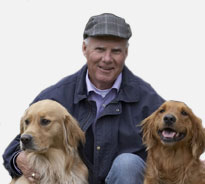
Many of you have, or may find yourself contemplating hiring an outside company or trainer to help you with the education of your dog. The following information is intended to offer some insight in to what to look for, should you need a trainer. I am one who clings to the belief that the single biggest compliment a trainer can get is a referral from a previous client. For you as a customer, I strongly recommend that you thoroughly research any trainer or facility you are contemplating hiring, and if possible talk to a prior client of this service provider.
A good trainer should at some point take care to emphasize the limited lack of effective or dependable knowledge about dog behavior circulating today. I have been working with dogs for nearly 30 years now and will not hesitate to tell you I simply don't believe we (humans) know a whole lot about them, at least in comparison to what is yet to be learned. Often I find myself reading articles written by self proclaimed "experts" and can't help but wonder if the writer has ever even seen a dog.
An important first step in hiring a trainer is to arrange a telephone conversation. If this leaves you feeling comfortable then proceed. If not, seek advice elsewhere. Animportant function of the initial home or phone interview is to prepare a client family psychologically and emotionally to work through the behavior problem successfully. This process involves much more than simply informing clients about dog behavior and learning; it includes sensitivity about their fears, disappointments and attitudes about the process itself. Clients must be made fully aware that behavioral change is not a magical remedy, but "a systematic and logical process that will require a personal commitment, self sacrifice, and a readiness to change ones own behavior in order to change the dogs behavior".
Effective councilors (trainers) will maintain relaxed and non-judgmental during the interview process. Perhaps the most important aspect of the initial telephone interview is the opportunity it gives a dog behavior consultant/trainer to assess the situation and decide whether to accept or decline a case.
The ability to recognize the limits of ones capabilities is a true sign of professionalism.
To change a dogs' behavior, the behavior of people interacting with the dog may also need to change. This is most often the case. I often say "to modify the dog is easy, to change the human, quite another story".
Although changing a dogs behavior is the ultimate goal (many means are provided to clients to achieve that end), to obtain lasting change, consistent with cynopraxic goals, a clients perception and behavior toward a dog may also require significant modification. This is almost always the case. Finally the physical environment may also need alteration. Where the dog eats, sleeps, plays, and is exercised or trained need also be examined. An experienced trainer will sum this all up in one glance upon visiting the client for the first time. Rarely is the client even aware of this mental evaluation by the trainer, unless of course environmental modifications are required. My personal experience has taught me that the single most important, and also the most difficult to modify, is the behavior of the client when around the dog.
In short I must say that an experienced trainer will address both antecedents as well as consequences. Knowing when to apply consequences, either positive or negative, is an art, an inner sense that cannot be learned from a book. In addition to altering unwanted behavior, experienced, knowledgeable and wise trainers are also adept at using antecedents and consequences to shape and control desirable behaviors.
L. Neilson

- Orderly training offering a variety of techniques
- Controlled incentives with intention and purpose
- Motivational incentives and rewards
- Activity success, error prediction and reward
- Propensity and disposition to learn
- Drive, arousal, and action
- Fair exchanges
|
Words Of Wisdom
A bird does not sing because it has an answer.
It sings because it has a song.
Small men think they are small; great men never know they are great.
I was angered, for I had no shoes. Then I met a man who had no feet.

Energy
A dog will judge you not on your physical appearance - but on the energy you radiate.
L. Neilson

|








